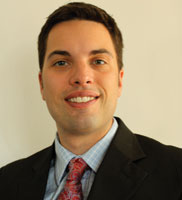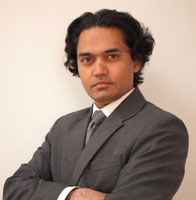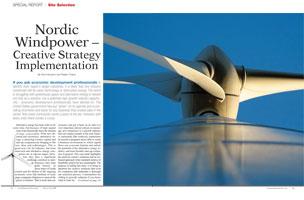
 If you ask economic development professionals to identify their region’s target industries, it is likely that one industry mentioned will be clean-technology or alternative energy. The world is struggling with greenhouse gases and alternative energy is viewed not only as a solution, but a potential high growth industry opportunity - economic development professionals have latched on. The United States government has put “green” on its agenda and is providing incentives and loans for any business that creates jobs in the sector. Now every community wants a piece of the pie. However, with every wish there comes a curse.
If you ask economic development professionals to identify their region’s target industries, it is likely that one industry mentioned will be clean-technology or alternative energy. The world is struggling with greenhouse gases and alternative energy is viewed not only as a solution, but a potential high growth industry opportunity - economic development professionals have latched on. The United States government has put “green” on its agenda and is providing incentives and loans for any business that creates jobs in the sector. Now every community wants a piece of the pie. However, with every wish there comes a curse.
Alternative energy has been with us for some time, but because of high capital costs it has historically been the domain of large corporations. With new demand and incentives, alternative energy is attracting venture capital and start-up companies are bringing to life new ideas and technologies. This is good news for the industry, but most clean-tech and alternative energy companies are in nascent stages, therefore they face a significant challenge common to start-up business, they lack credit history. In these times of credit crunch and the fallout of the ongoing economic crisis this attribute of early stage companies threatens to unravel the “green revolution.” But to kick-start our economy and get it back on its rails it is very important, almost critical, to encourage new businesses in a growth industry that can employ people in the near future. A community that creatively implements its incentive programs and is able to create a business environment in which capital flows can overcome barriers and unlock the potential of the alternative energy industry; and more broadly start-up companies in general. This case study highlights the need for creative solutions and an unbiased approach when standard metrics of feasibility tend to be less meaningful. The purpose of telling this story is to bring to attention the creative solutions that exist for companies that undertake a thorough site selection process. Communities are willing to provide solutions if you know what to look for.
Nordic Windpower: An Overview
The location strategy and site selection team at Newmark Knight Frank (NKF) recently advised Nordic Windpower (Nordic), an early-stage wind turbine manufacturer, in the identification of an optimal expansion location. The goal was to find a community that could provide a suitable business environment for a substantial new manufacturing and corporate offices facility. Nordic is now in the process of consolidating their production operations and corporate headquarters in Platte County near Kansas City, Missouri.
 Nordic formed in 2007 after acquiring advanced turbine design and technology developed in Sweden. Their intellectual property was combined with generous government grants to create the opportunity to seriously enter the turbine market. Nordic designs, builds and installs two-blade wind turbines for communities or businesses. Unlike wind farms which transport power via the grid long distances, Nordic’s technology is intended to produce energy on site and be consumed entirely by the customer. At the outset of this project, Nordic’s headquarters were in Berkeley, California, providing access to venture capitalists from whom they had secured investment. To capitalize on low costs, their assembly operations were in Pocatello, Idaho, and their engineering design unit was in the United Kingdom. It was decided by Nordic’s leadership and their board that to compete Nordic needed to consolidate its operations in an optimal location.
Nordic formed in 2007 after acquiring advanced turbine design and technology developed in Sweden. Their intellectual property was combined with generous government grants to create the opportunity to seriously enter the turbine market. Nordic designs, builds and installs two-blade wind turbines for communities or businesses. Unlike wind farms which transport power via the grid long distances, Nordic’s technology is intended to produce energy on site and be consumed entirely by the customer. At the outset of this project, Nordic’s headquarters were in Berkeley, California, providing access to venture capitalists from whom they had secured investment. To capitalize on low costs, their assembly operations were in Pocatello, Idaho, and their engineering design unit was in the United Kingdom. It was decided by Nordic’s leadership and their board that to compete Nordic needed to consolidate its operations in an optimal location.
To begin the selection process the NKF team delineated a triangle between Minneapolis, Indianapolis and Dallas; encompassing the wind-rich states where wind turbine customers resided. It was important to be near a first or second tier airport because the Nordic engineers would travel frequently to installation sites. This requirement narrowed the scope to Chicago, Milwaukee, Minneapolis, Indianapolis, Kansas City and Dallas-Fort Worth.
Because of the size and mass of Nordic’s turbines the company assumed transportation costs would drive the location decision. To test this theory NKF developed a logistics network optimization model to identify inbound and outbound costs. The model revealed that all of the locations in questions were on par. This was a significant discovery and represented a departure in Nordic’s conventional thinking. However, because Nordic entered the process willing to explore even preconceived notions, the process was able to focus on identifying the best business environment, as oppose to optimizing logistics; an important distinction for long term business success.
An RFP was sent to the six communities seeking assistance in the search for ready to occupy facilities that could accommodate the unusual specifications for wind turbine assembly. Nordic’s assembly operation required 35-foot clear height and cranes that could lift 55-ton assembled turbines. Floors needed to be designed to take high point load, and the facility needed to accommodate the pass-thru of 135-foot flat bed trucks (lowboys). A ready-to-occupy facility was the preferred solution because Nordic’s lease in Pocatello was coming to an end, and they wanted to start their new operation at the earliest possible. Upon review of all the properties submitted the team found very few met Nordic’s criteria. Build-to-suit opportunities were also explored, but few developers were interested in committing to a fast track timeline of twelve months.
 Comparative analysis of real estate alternatives, airport proximity, logistics, operating cost, incentives, etc. narrowed down the candidate locations to two communities – Kansas City, Missouri, and Denton, Texas. At this stage it was expected that the consulting team would start negotiations in earnest with the two finalists. Since the available facilities were not adequate or optimal to accommodate Nordic’s unique needs, it was decided that a build-to-suit facility would be the only feasible alternative. To move the project to the next phase Nordic signed a non-disclosure agreement (NDA) with the communities and shared their financial statements with prospective developers. That is when the process stalled. Developers found it difficult to raise money from investors for the build-to-suit because Nordic did not have a long credit history and most of their revenues were only projections. This made the project higher risk than developers were willing to accept. The incentive packages from both the states of Texas and Missouri were very attractive, but they were irrelevant if the project was not going to be built. Both communities were very eager to attract Nordic, but the decision now hinged on getting the project over the goal line.
Comparative analysis of real estate alternatives, airport proximity, logistics, operating cost, incentives, etc. narrowed down the candidate locations to two communities – Kansas City, Missouri, and Denton, Texas. At this stage it was expected that the consulting team would start negotiations in earnest with the two finalists. Since the available facilities were not adequate or optimal to accommodate Nordic’s unique needs, it was decided that a build-to-suit facility would be the only feasible alternative. To move the project to the next phase Nordic signed a non-disclosure agreement (NDA) with the communities and shared their financial statements with prospective developers. That is when the process stalled. Developers found it difficult to raise money from investors for the build-to-suit because Nordic did not have a long credit history and most of their revenues were only projections. This made the project higher risk than developers were willing to accept. The incentive packages from both the states of Texas and Missouri were very attractive, but they were irrelevant if the project was not going to be built. Both communities were very eager to attract Nordic, but the decision now hinged on getting the project over the goal line.
Community Initiative and Creative Thinking
After the process had identified the two optimal locations, a board member for Nordic suggested a state in the Southeast that had not originally been in the search area. However, this state could offer enough cash incentives to make the project possible. This was a very real opportunity and suddenly felt like the only possible solution. However, the team of consultants and the Nordic executives wanted to stay true to the location search process. Research on the attractiveness, business and demographic attributes of the newly introduced candidate state revealed it did not meet the critical criteria of labor availability or proximity to a major airport. A hard decision was made to not be distracted by the seemingly golden opportunity, and remain focused on the two finalist locations.
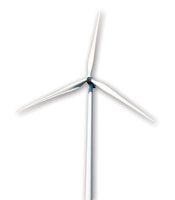 In the meantime, the adversity spurred creativity among the Kansas City and State of Missouri economic development teams who had demonstrated their eagerness to attract this business through constant engagement. Because of the challenge posed by Nordic’s financial statements, the NKF consulting team suggested Nordic take a higher discount rate to reflect the risk perception of the developer. Then, if the credit guarantee could be taken either by the state, city or county, the developer discount rate would be much lower because of a favorable risk profile. Nordic could then pay a lease calculated at the higher rate, and the developer would structure the lease calculated at the discount rate for the state, city or county. The difference would be kept in escrow for the duration of the lease. When the lease was ready to be renewed Nordic would have developed a proven stream of revenue and creditworthiness, allowing the escrowed amount to be released to Nordic in the form of free rent in future years. This seemed like a workable solution, but it would have resulted in a very high initial lease rate for Nordic. Considering at the time they were a venture backed company without substantial cash flow the initial lease rate was not something they could absorb.
In the meantime, the adversity spurred creativity among the Kansas City and State of Missouri economic development teams who had demonstrated their eagerness to attract this business through constant engagement. Because of the challenge posed by Nordic’s financial statements, the NKF consulting team suggested Nordic take a higher discount rate to reflect the risk perception of the developer. Then, if the credit guarantee could be taken either by the state, city or county, the developer discount rate would be much lower because of a favorable risk profile. Nordic could then pay a lease calculated at the higher rate, and the developer would structure the lease calculated at the discount rate for the state, city or county. The difference would be kept in escrow for the duration of the lease. When the lease was ready to be renewed Nordic would have developed a proven stream of revenue and creditworthiness, allowing the escrowed amount to be released to Nordic in the form of free rent in future years. This seemed like a workable solution, but it would have resulted in a very high initial lease rate for Nordic. Considering at the time they were a venture backed company without substantial cash flow the initial lease rate was not something they could absorb.
In the light of this reality Nordic needed to find ways to reduce cost and secure capital for building equity. The result was a series of small compromises and creative solutions:
To lower the cost of facility, Nordic worked with various industrial developers and the NKF team to redefine requirements and redesign the facility plan. Overhead cranes made way for movable gantry cranes and movable platforms on rails. This brought down the building height and width requirement, and reduced the size and cost of the facility.
Earlier in the site selection process the NKF team had dropped from consideration a site near the airport because it would not allow Nordic to erect a wind turbine (an initial requirement) because of height restrictions in the airport zone. However, the Airport site was in Platte County; a location that had special incentives for this type of development. The county was able to offer cash upfront equal to the present value of the applicable incentives. Monetizing the incentives required an approval by the State of Missouri. The project secured the approval because of the business case made by Platte County and their initiative in lobbying for Nordic.
The airport authority offered the use of a super-hangar previously vacated by American Airlines. The hangar had very high ceilings, a floor designed to withstand heavy load and was near a highway. It was proposed as a temporary assembly facility for Nordic while the developer built their new building.
Through strategic cost reduction and capital generation Nordic was able to use the nearly four million dollars of monetized incentives as equity in the building. All these measures lowered the developer risk who then agreed to put in the remaining amount for the construction cost. Although each individual project change and creative solution seemed minimal, together they created an environment where the project could succeed.
Lessons Learned
Just when it seemed this project would not see the light of day, all entities involved – the client, developers, economic development teams, airport authority, Platte County, and the consultants – adjusted their expectations to make the project feasible. But the key factor that influenced everyone to act was the ability of Platte County to use creative financing that would monetize incentives for upfront use.
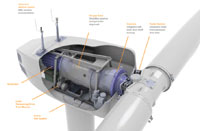 Communities that want to attract entrepreneurs and start-up businesses have to create a business environment that is sensitive to their very unique needs, the most import being financial risk management. Sometimes it means that a community has to share risk, as we saw in the case of Platte County, and it can change a project that seems impossible into a project that is realistic and scaled efficiently. For a company engaged in a site selection project this story illustrates the importance of remaining focused on a process and diligently pursuing communities to solve complex problems. Never assume you know the primary driver of business success, and do not be afraid to expect a partnership from your local community, county or state. Together, the public and private sector can overcome the hurdles of a post recession economy and create exciting opportunities for new business initiatives.
Communities that want to attract entrepreneurs and start-up businesses have to create a business environment that is sensitive to their very unique needs, the most import being financial risk management. Sometimes it means that a community has to share risk, as we saw in the case of Platte County, and it can change a project that seems impossible into a project that is realistic and scaled efficiently. For a company engaged in a site selection project this story illustrates the importance of remaining focused on a process and diligently pursuing communities to solve complex problems. Never assume you know the primary driver of business success, and do not be afraid to expect a partnership from your local community, county or state. Together, the public and private sector can overcome the hurdles of a post recession economy and create exciting opportunities for new business initiatives.

